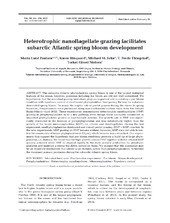Heterotrophic nanoflagellate grazing facilitates subarctic Atlantic spring bloom development
Peer reviewed, Journal article
Published version

Åpne
Permanent lenke
https://hdl.handle.net/1956/17357Utgivelsesdato
2017Metadata
Vis full innførselSamlinger
Sammendrag
The subarctic Atlantic phytoplankton spring bloom is one of the largest biological features of the ocean; however, processes initiating the bloom are still not well understood. We hypothesize that the microbial grazing food chain plays an important role in creating a pre-bloom condition with top-down control of small-sized phytoplankton, thus paving the way for a diatomdominated spring bloom. To assess the trophic role of protist grazers during the winter to spring transition, 3 experiments were performed using size-fractionated surface water from the Iceland Basin (March−April 2012). These experiments demonstrated heterotrophic nanoflagellates (HNF) grazing of picophytoplankton to be a key pathway, even though these are rarely considered as important phytoplankton grazers in high-latitude systems. The growth rate of HNF was significantly correlated to the biomass of picophytoplankton and was substantially higher than the growth of the larger microzooplankton (MZP), i.e. ciliates and dinoflagellates. During the first experiment, small phytoplankton dominated and overall protist grazing (HNF + MZP) was low. In the later experiments, MZP grazing on HNF became evident; however, MZP were not able to control the community of larger phytoplankton (>10 μm), which became more abundant. Our experiments thus support the hypothesis that pre-bloom conditions promote a build-up of large phytoplankton, i.e. diatoms. We found that the high growth rates of HNF together with the relaxed MZP grazing pressure allow HNF to respond rapidly to the early primary production by picophytoplankton and maintain a strong top-down control on these. We suggest that this succession may be an important mechanism that allows large diatoms, rather than picophytoplankton, to become the dominant primary producers during the subarctic Atlantic spring bloom.